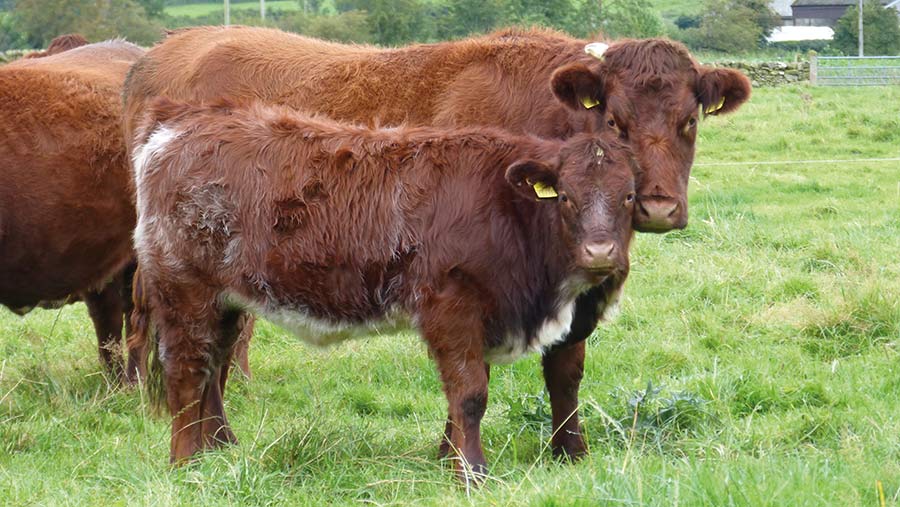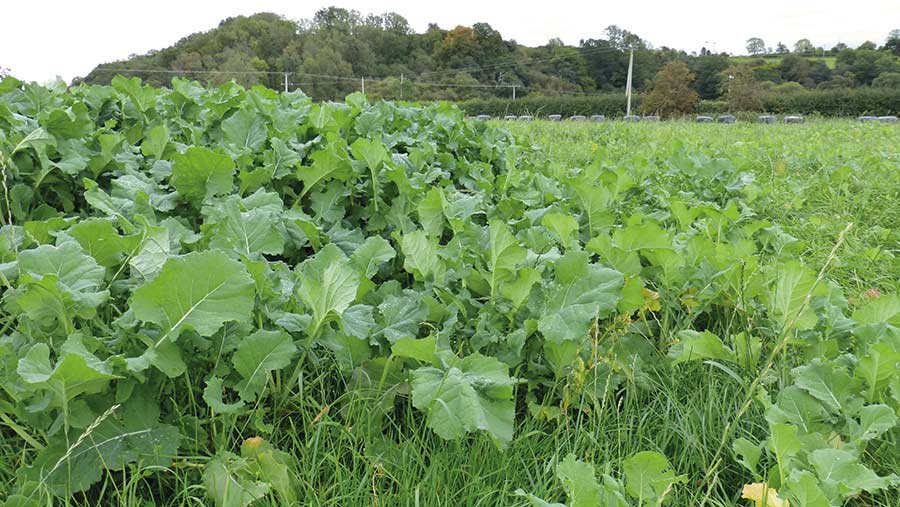How outwintering cut suckler farm costs to 243p/kg
 Calves grow off milk and grass and average 44% of their dam's weight at weaning © Michael Priestley
Calves grow off milk and grass and average 44% of their dam's weight at weaning © Michael Priestley Outwintering youngstock and stores has been the final piece in the profitability jigsaw for a first-generation Scottish tenant farmer.
Former Farmer Focus writer Giles Henry, of Oakwood Mill, Selkirk, has managed to stop housing cattle and – after all household drawings – is seeing a slim margin before subsidy.
His pure Luing cows have been farmed organically since 2000 and rotationally grazed since 2010. Cows have been outwintered on a rough hill adjacent to the farm since the Henrys started on the Buccleuch Estate tenancy in 1996.
But it was only in 2014 that the seven-month housed youngstock winter was eradicated, and with it the cost of straw, time, machinery depreciation and 200t of clamp grass silage.
See also: How beef herd is delivering £350/cow net profit with deferred, mob grazing
Farm Facts

Giles Henry © MAG Michael Priestley
- 75 pure Luings (Ettrick prefix)
- Supplying Dovecote Park
- 105ha (259 acres) of land farmed on Buccleugh Estate tenancy
- 114ha (282 acres) of hill rented for outwintering
- Sub-letting sheds for 4,000 organic layers
- 1,222mm of rain a year
- Some bulls and breeding heifers sold privately at society sales
- Tag and testing for BVD and Johne’s accredited
- Contract finishing 45-50 Angus steers
Winter
Mr Henry’s system (see wintering plan table, below) has enabled him to sell his forage wagon and get by with just one 100hp tractor and a utility terrain vehicle to check stock.
Mr Henry says he has cut about £2/kg off his costs (see costs table, below) since 2014, when he made the switch to outwintering.
Previously, all youngstock were housed in buildings or a slatted shed. The farm used to put 350t of grass silage in a clamp each year and used concentrate and minerals to balance silage.
An organic egg business on the farm – previously run by the Henrys – supplies phosphate and potash for the winter crop ground, which goes down for a year or two, to be followed with six or seven years of clover and ryegrass leys.

A kale/rape hybrid is sown in old swards in July to winter weaned calves © Michael Priestley
Winter crops are drilled after a grazing period or silage cut, disced three times, seeded with a seed box and rolled. The farm does the discing work, contractors do the rest.
The farm is nicely laid out either side of a quiet main road, meaning cattle can be easily walked round the farm and money is saved on running a pickup.
Cattle are finished in May-July achieving 1.45kg a head/day on grass and clover leys at 24-30 months. Faecal egg counts monitor liver fluke.
Wintering plan at Oakwood Mill |
||
|
Livestock and management |
Costs and budget |
Considerations |
|
Cows • Walked up to 114ha mossy, rough hill in early November to leave average farm covers at 1,800kg dry matter/ha to be at 1,900kg by 1 January. • Cows can manage on energy blocks and dry cow rolls and deferred grazing. • In spring cows return |
• 50-62p a cow a day depending on the amount of snow. • Depending on amount of supplementary feeding it costs £80-£100 a cow for a 160-day winter including rent of the hill. • Budget on 4ha (1.62ha) a cow for the winter.
|
• Hardy Luing cows burrow to find forage in a light snow fall. Only 20 bales of hay have been fed in 24 years. • Energy buckets are provided for rumen-degradable protein and energy to break down forage. • A few weeks before calving, Mr Henry goes up daily with cobs to allow closer observation. • Cows need to be at body condition score 3.5-4 in the autumn to help them through the winter. |
|
Calves • October weaned behind an electric fence for three-to-four days and introduced to kale through on-off grazing for a few hours for four days.
|
• Redstart (kale/rape hybrid) is grown at a cost of £172/ha (£70/acre). • Expected yield is about 7t DM/ha. • This year 71 calves will go into 8ha for the winter on daily shifts. • Costs 12p a head a day in variable costs. |
• A dependence on forage limits the cost-effective finishing period for the farm. • The bulk of cattle are finished on May-July at 24-26 months. • Outwintering means no vaccine costs other than bovine viral diarrhoea. Only one case of pneumonia has been treated in seven years. • 200 bales of grass silage have been made for the calves. Weight gains of about 0.5-0.6kg a head a day is expected.
|
|
Stores • Home-bred calves spend their second winter on a forage total mixed ration (TMR) including beans, turnips and forage radish. • Growth of 0.6kg a head/day is expected. Cattle then finish in spring/summer on clover and ryegrass.
|
• 20p a head a day for forage TMR. • The farm is still experimenting with mixes and diet, but is hopeful beans and the mixed crop provides enough fibre without requiring costly silage and straw. • Conservatively budgeting at 6t DM/ha. |
• The farm is able to take on 45-50 head of organic Angus cross cattle from another farm and finish them in a profit-sharing enterprise. • 15ha of forage TMR has been grown for about 120-head of cattle in total. • A shed full of straw was bought “just in case” in 2018 and is still all there. This could be used to help the cattle eat the TMR if needed, but it wasn’t last year. • Contract-finish store cattle are wintered this way too. |
Summer grazing
Cows come off the hill around 1 April to calve. Bulling only lasts for six weeks in June/July.
Bull calves are ring castrated at birth and calves rotationally graze all summer in mobs of 20 in 1ha blocks moving every one-to-three days. Each mob has eight paddocks.
“It cost me less than £8,000 to convert the fields to paddock grazing and I’ve lifted my stocking rate 30%. It would cost me that every year to rent the same amount of grass parks,” explains Mr Henry.
Mature cow weaning efficiency has lifted from an average of 33% to 44% over the past seven years.
This has been achieved by reducing weight by 40kg to 610kg and pitching one electric wire high enough to allow calves to explore and preferentially graze.
Mr Henry looks to increase selection pressure on the cows and may start Signet recording now the farm is approaching capacity after selling off its 300-head Cheviot flock in 2018.
Production costs at Oakwood Mill |
|
|
Costs per liveweight kg produced |
£/kg liveweight produced |
|
Purchased feed and forage |
0.40 |
|
Purchased fertiliser (including lime) |
0.08 |
|
Purchased minerals |
0 |
|
Vet and medicine |
0.18 |
|
Seed and sprays |
0.10 |
|
Contractor charges |
0.24 |
|
Grazing rents |
0.15 |
|
Other variable costs |
0.37 |
|
Power and machinery |
0.23 |
|
Administrative (drawings, family spending) |
0.21 |
|
Property costs |
0.21 |
|
Rent |
0.26 |
|
Finance |
0 |
|
Total costs |
2.43 |
|
|
The numbers
- 8 How many tonnes of DM/ha is grown on the grazing platform each year
- 325 Average carcass weight for steers and heifers (kg)
- 10 Number of rope-assisted calvings in 25 years
- 610 Average mature cow weight (kg)
- 94% Calves weaned for every 100 cows bulled
